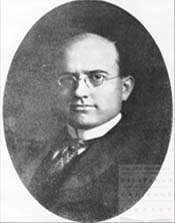Lebbeus R. Wilfley

Lebbeus Redman Wilfley (March 30, 1866 – May 26, 1926) was an American attorney who served as Attorney General of the Philippines and as a judge of the United States Court for China.
Early life and career
Born in Mexico, Audrain County, Missouri, Lebbeus received an A.M. from Central Methodist University in Fayette, Missouri in 1889 and a LL.B. from Yale Law School in 1892. He entered private practice in St. Louis, Missouri, where he was joined in 1899 by his brother, Xenophon Pierce Wilfley.[1] In 1901, William Howard Taft, then Governor-General of the Philippines, appointed Wilfley Attorney General of the Philippines. Wilfley served in that position from 1901 to 1906.
Federal judicial service
In 1906, the U.S. congress established a special court for the "District of China" the United States Court for China, based in the Shanghai International Settlement which had extraterritorial power to try United States Citizens in China. Wilfley was appointed the first judge of this court by President Theodore Roosevelt in July 1906. With no obligation to follow the strictures of the constitution or local law, there were many complaints by American expatriates, especially one by Lorrin Andrews, former Attorney General of the Territory of Hawaii, who charged that Wilfley had voided a will by a person leaving some of his money to the Catholic Church because of his prejudice against it.[2]
On February 20, 1908, United States Representative George E. Waldo introduced articles of impeachment against Wilfley and the resolution was referred to the Judiciary Committee.[3] Leaving the court in chaos, Wilfley traveled halfway around the world to attend the hearings in Washington, D.C.
On May 8, 1908, the United States House Committee on the Judiciary submitted a report, H.R. Rep. No. 60-1626, to the House recommending against impeachment.[4]
In November 1908, HD O'Shea, the editor of the China Gazette in Shanghai was prosecuted in the British Supreme Court for China and Corea for criminal libel against Wilfley relating to an article published in the China Gazette in August 1908 concerning the charges against Wilfley and Wilfley's testimony to Congress. O'Shea was convicted by a jury and sentenced to 2 months imprisonment.[5]
Despite O'Shea's conviction, the situation was so poisoned, Wilfley resigned at the end of 1908 and returned to the U.S. for good.[6]
Later life
Wilfley thereafter practiced in Missouri and New York. In 1909, Clark University conferred an LL.D on him. In 1911, the Chinese government hired him to investigate the Torreón massacre, in which over 300 Chinese were killed.
On January 27, 1917, Wilfley married Belle L. Zabriskie (née Loader), widow of entrepreneur Alanzo M. Zabriskie. Wilfley was practicing in New York at the time.[7]
Death
He died in Greenwich, Connecticut at the age of 60.
Further reading
- Clark, Douglas (2015). Gunboat Justice: British and American Law Courts in China and Japan (1842-1943). Hong Kong: Earnshaw Books., Vol. 1: ISBN 978-988-82730-8-9; Vol. 2: ISBN 978-988-82730-9-6; Vol. 3: ISBN 978-988-82731-9-5
- Scully, Eileen P. (2001). Bargaining with the State from Afar: American Citizenship in Treaty Port China, 1842-1942. Columbia University Press. ISBN 978-0-231-12109-5.
References
- ↑ John W. Leonard, The Book of St. Louisans (1906), p. 611.
- ↑ http://query.nytimes.com/mem/archive-free/pdf?_r=1&res=9805E7D8103EE033A25753C1A9679D946697D6CF
- ↑ 42 Cong. Rec. 2269 (1908).
- ↑ Id. at 5965
- ↑ North China Herald, November 1908, p431
- ↑ http://query.nytimes.com/mem/archive-free/pdf?res=9F07E5DA1738E033A25752C1A9679C946897D6CF
- ↑ "Mrs. Zabriskie Wed To Ex-Judge Wilfley", New York Times, January 28, 1917.